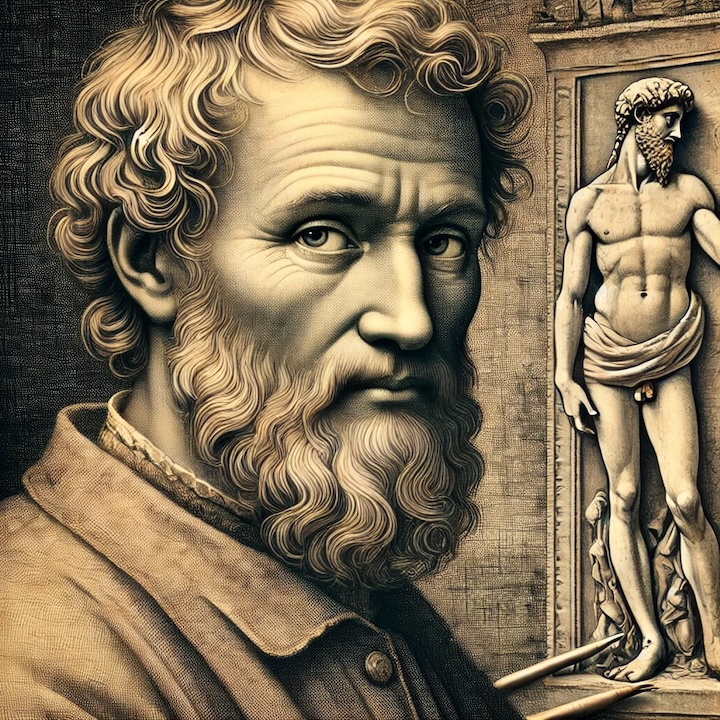Michelangelo di Lodovico Buonarroti (1475-1564)

Michelangelo, a pivotal figure of the Italian Renaissance, was renowned for his mastery in painting, sculpture, and poetry. Although he considered himself primarily a sculptor, his Sistine Chapel frescoes are among the most celebrated works of art. Michelangelo’s notable sculptures include The Pietà, David, and Moses. His influence extended to architecture, most notably his role as the architect of St. Peter’s Basilica.
Michelangelo Buonarroti was born on March 6, 1475, in the small village of Caprese, near Arezzo, in the Republic of Florence. His family belonged to minor nobility, though they were not particularly wealthy. Shortly after Michelangelo’s birth, the family moved back to Florence, a thriving cultural center of the Italian Renaissance. Florence’s vibrant artistic environment would play a crucial role in shaping the young Michelangelo’s talents and aspirations.
From an early age, Michelangelo showed an interest in the arts, though his father initially disapproved of this path, preferring that his son pursue a more traditional career. However, by the age of 13, Michelangelo had become an apprentice to Domenico Ghirlandaio, one of Florence’s most prominent painters at the time. Under Ghirlandaio’s tutelage, Michelangelo was introduced to the techniques of fresco painting and quickly distinguished himself for his talent.
In 1489, Michelangelo’s extraordinary skill attracted the attention of Lorenzo de’ Medici, the de facto ruler of Florence and a major patron of the arts. Lorenzo invited the young artist to study at his court, where Michelangelo had the opportunity to learn from the city’s leading scholars and artists. It was during this period that Michelangelo first became deeply influenced by classical sculpture and philosophy, laying the foundation for the masterpieces he would later create. The Medici court was also where he became acquainted with future popes, philosophers, and poets, further broadening his intellectual horizons.
By the time he left the Medici court, Michelangelo was already gaining a reputation as a prodigy. His first significant commissions came in his early twenties, and he quickly became one of the most sought-after artists in Italy.
Though Michelangelo is often remembered for his breathtaking frescoes in the Sistine Chapel, he saw himself primarily as a sculptor. He believed that sculpting allowed him to bring life to stone, giving form and emotion to the cold marble blocks he worked with. One of his earliest masterpieces, The Pietà, completed in 1499 when Michelangelo was only 24, depicts the Virgin Mary cradling the dead body of Jesus with a stunning balance of grace and emotion. The work’s delicate beauty and incredible attention to detail, especially in Mary’s robes and Christ’s serene expression, established Michelangelo as a master of his craft.
Michelangelo’s sculpture of David, completed in 1504, further solidified his reputation. Standing at 17 feet tall, the marble statue portrays the biblical hero in a moment of calm before his battle with Goliath. This statue, carved from a single block of marble, represents the pinnacle of Renaissance ideals—heroism, physical perfection, and human beauty. David’s intense gaze and detailed musculature reflect Michelangelo’s ability to convey both emotion and physical strength through stone.
In addition to his sculptural work, Michelangelo made a monumental contribution to painting. His frescoes on the ceiling of the Sistine Chapel in Vatican City are widely regarded as one of the greatest artistic achievements in history. Painted between 1508 and 1512, the ceiling’s central panels depict stories from the Book of Genesis, including The Creation of Adam, one of the most iconic images in Western art. Despite his self-identification as a sculptor, Michelangelo’s ability to work on such a large scale in a medium outside his preference attests to his genius.
Michelangelo’s talents were not confined to visual art alone. He was also a prolific poet, composing over 300 sonnets and madrigals throughout his life. His poetry reveals the inner workings of a deeply philosophical mind, exploring themes of love, beauty, and spirituality. This side of his artistry is less well-known, yet it reflects his Renaissance spirit—a man of many talents, driven by a thirst for knowledge and expression.
Later in life, Michelangelo turned to architecture. In 1547, Pope Paul III appointed him as the chief architect of St. Peter’s Basilica in Vatican City, a role he held until his death in 1564. Michelangelo’s redesign of the Basilica’s dome became an architectural marvel, influencing church designs across Europe for centuries. Though he did not live to see its completion, the dome remains one of the most recognizable elements of the Vatican skyline.
Michelangelo passed away on February 18, 1564, in Rome, at the age of 88. His body was taken back to Florence, in accordance with his wishes, and he was laid to rest in the Basilica of Santa Croce. His death marked the end of an era, as he was one of the last great figures of the Italian Renaissance.
 >
>